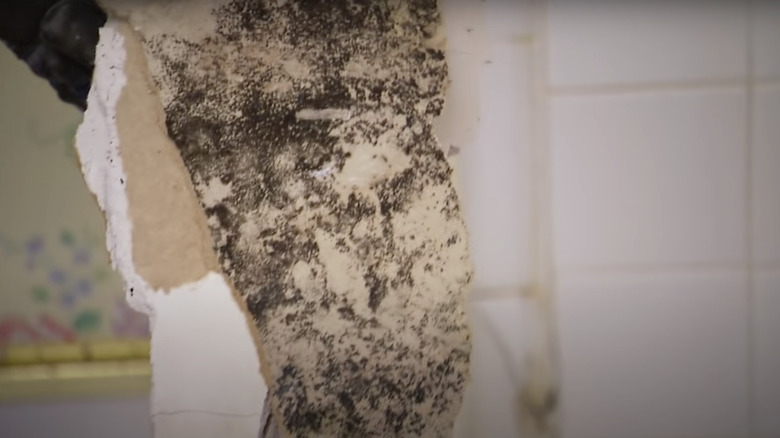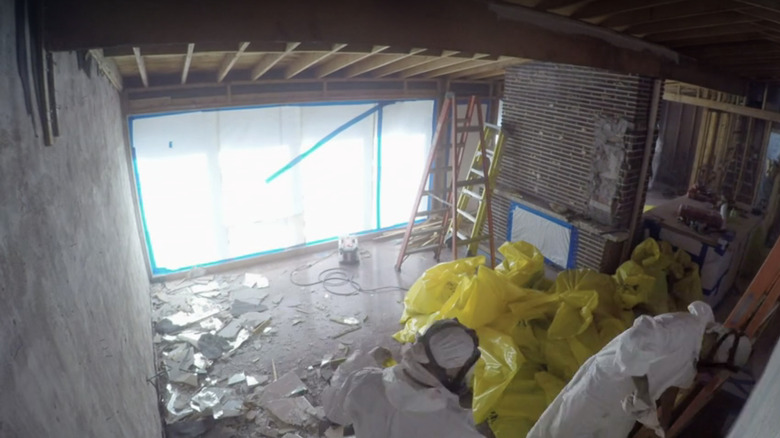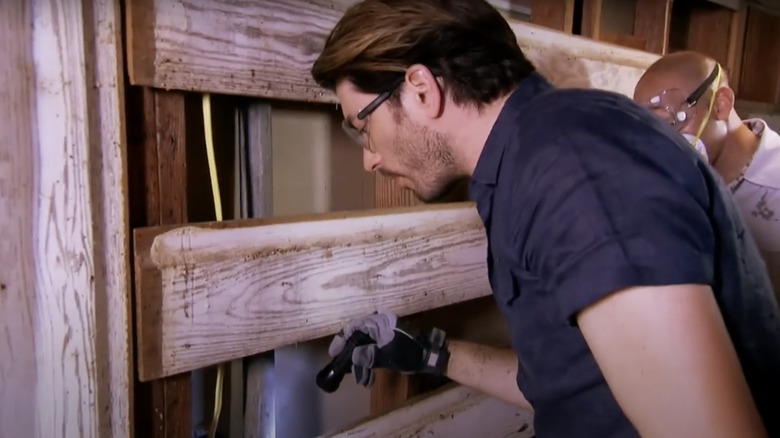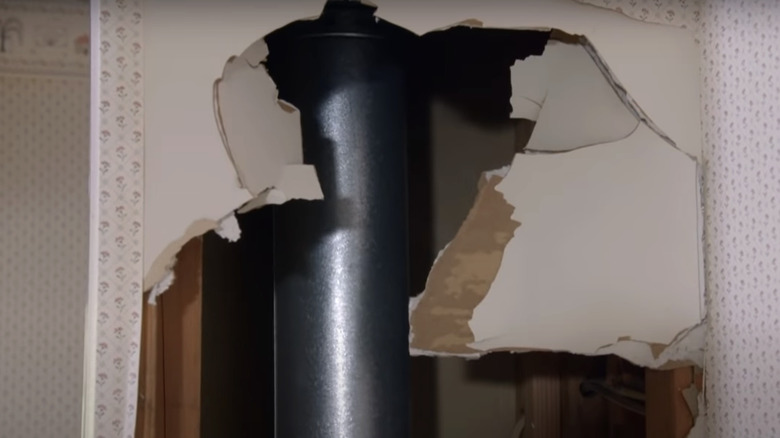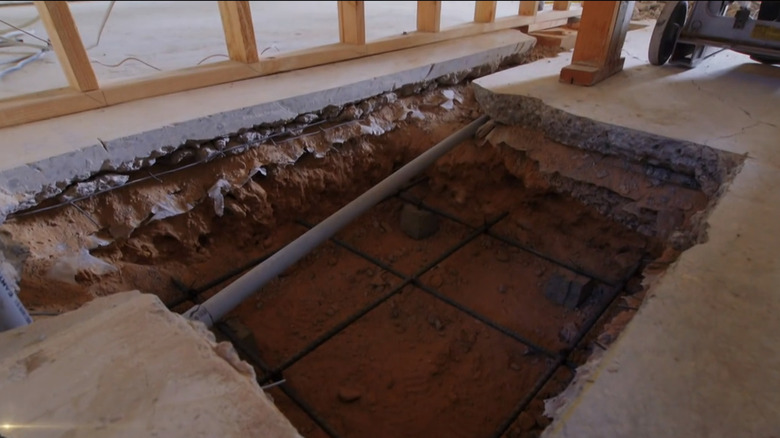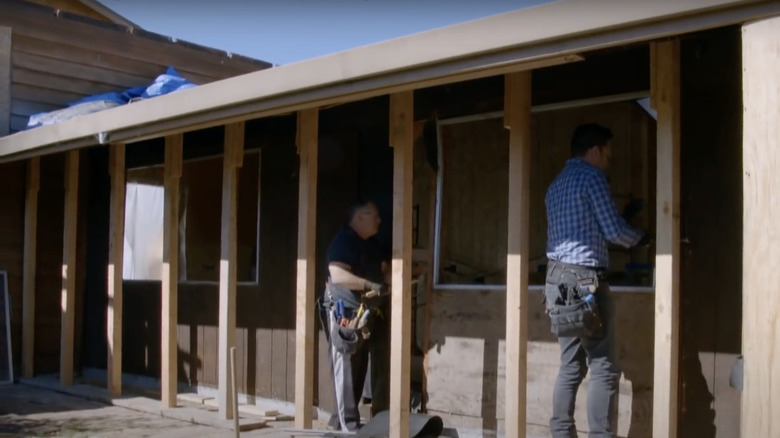The 7 Worst Issues The Property Brothers Have Encountered In A Reno
We may receive a commission on purchases made from links.
Renovations can reveal a host of scary surprises, and the Property Brothers are no stranger to these unexpected issues. Their media career began with Drew presenting himself as the real estate specialist and Johnathan as the general contractor. Throughout the years, their roles became more equal, and they built a home renovation empire. From their early years on "Buying + Selling," to their more recent series "Brother Vs. Brother," they have seen it all when it comes to remodeling single-family homes.
There's no telling what lies behind walls or underneath the foundation of homes until you start the demolition process. While Jonathan and Drew are always enthusiastic about busting through drywall and smashing concrete, they're not always thrilled with what they find. From mold to legal issues, the solutions range from expensive to astronomical. If you're embarking on your own renovation journey, use these episodes as guides on what to look out for and how to properly rectify unexpected setbacks.
A master bathroom that was riddled with mold because of drywall around the shower
In Season 3, Episode 9, of "Buying + Selling," Lazarus and Evonna had initial intentions of restoring their vintage home. However, all of their money ended up going towards an unexpected water problem that was infiltrating their foundation. By the time Drew and Jonathan inspected the house, the biggest remaining issue was the master bathroom. While it already appeared dated, they couldn't have anticipated the extensive level of water damage. The couple had already dealt with mold in their basement, and they were overwhelmed to find out there was severe mold underneath their tub. "That's why we don't put drywall around a shower," Jonathan explained. Instead, you're supposed to install greenboard, blueboard, or concrete backing, which are specifically designed to be water-resistant, lowering your risk for mold or mildew.
Mold in bathrooms is not uncommon, but that doesn't mean it should be taken lightly. Unfortunately, in older bathrooms, moisture can get trapped for a variety of reasons. Whether there are cracks in the pipes or a lack of proper ventilation, mold will take advantage of any damp environment. When you purchase a home, ensure that your hired inspector checks for signs of mold. Materials that are not suitable for direct exposure to water include carpet, drywall, and wood flooring. In Lazarus and Evonna's bathroom, Jonathan removed the carpet and drywall around the tub and then added blueboard and new tile, which is a perfect choice since it's one of the best materials for renovating your bathroom floor.
An old foundation that needed steel footings before renovations could begin
The stakes were high in Season 4, Episode 1, of "Brother Vs. Brother." Jonathan and Drew were racing each other to the finish line with their Vegas renovations. In order to proceed with his remodel, the city told Jonathan that he had to dig footings to bear the weight of the home and ensure it was up to code. He and his team had to go underneath the foundation of the home and reinforce it with steel. An engineer from the city had to sign off on the new support system before Jonathan could allow his team to start any major renovations.
While Jonathan received his permit just in time, these kinds of issues can be hard to rectify in a short period of time. If you're planning on renovating a home, it is essential to make sure that major elements like the foundation are up to code. If they are not up to the current building codes, or there are portions of the home that are unpermitted, you need to make some major room in your budget. It's never a guarantee that the city will approve the renovations if the structure was deemed unsafe to begin with. If you already own your home, it's recommended to check your foundation every 3-6 months, including watching for cracks along your floors and walls as well as bulging and bowing.
An old house that needed $20,000 worth of asbestos removal
In "Property Brothers" Season 12, Episode 14, the clients did not heed Drew's initial advice. While he warned against paying too much for an older home that could be harboring issues, Dereck and Christine ignored his advice and paid $65,000 over asking. They received a shocking surprise when they found out the home was riddled with asbestos. While the team was able to successfully rid the home of the carcinogen, it didn't come without a hefty cost. The invoice for abatement was around $20,000, eating into their already shrunken budget.
Unfortunately, asbestos used to be a common material used in the construction of American homes. It's a good idea to get your home tested for asbestos if your home was built prior to the 1980s. Around the 1970s, studies started to be released regarding the severe health effects resulting from the use of this material. The reason it is particularly important to get testing done prior to a renovation is because asbestos is more dangerous if it is disturbed, according to the Environmental Protection Agency (EPA). Testing can be expensive, which is why many potential buyers often forgo hiring a specific asbestos specialist during the inspection process. However, catching these issues early can give you a better idea of whether you want to move forward with the renovation.
A house with pests behind walls and leaking sewer gas
In Season 1, Episode 9, of "Buying + Selling," there was not just one issue; there were several. Sadly, Halley and Justin's home was full of one nasty surprise after another. The first skin-crawling reveal were the dead cockroaches and other pests inside the walls. More detrimental, however, was the rainwater trickling dangerously close to an electrical box. Last but not least, without a trap on the sewage pipe, toxic gases were rising back up into the wall cavity.
It's difficult to know what's going on behind your walls, especially if you own an older home. However, Halley and Justin mentioned that they had smelled a weird smell when walking past the wall in question. If you ever smell something moist, rotten, or generally unpleasant, don't ignore the warning signs. Always trust your senses and investigate or hire a professional. The couple ended up having to get a loan to cover the extensive repairs on their home, which could have been avoided if they had identified the problems earlier. For example, there are ways to tell if your walls are full of unwanted pests before the issue gets out of hand.
Duct work that was covered in cigarette residue
"Brother Vs. Brother" Season 6, Episode 2, presented Drew with some tricky issues. Most notably, he discovered a furnace pipe directly in the center of the kitchen. Not only did that make it difficult to execute his original open floor plan idea, but the furnace was filled with smoke residue from the previous owners. That meant that anytime the furnace was flipped on, the whole house would smell like stale cigarettes. He realized he had to replace all of the duct work in the entire house.
Smoking in your home can severely impact its resale value. If you have already purchased a home with smoke damage, there are a few things you can do to minimize the effects. First, purchase an air purifier like this Medify HEPA filter from Amazon. Filling bowls with vinegar is another DIY method, and it works because the acetic acid in vinegar breaks down the alkaline molecules present in cigarette smoke. You can also sprinkle baking soda on fabrics and textiles. If the smoke has gotten trapped inside your vents, you can try replacing the filters and having the ducts professionally vacuumed. If all else fails, you may have to replace the ductwork like Jonathan.
Flooring that was cracking due to inadequate structural support
After removing the carpet from the living space in "Property Brothers" Season 14, Episode 11, Jonathan was met with a conundrum. Cracks appeared in questionable striations, all leading toward a specific spot on the floor. Sure enough, the foundation wasn't just damaged; it was way too thin with very little reinforcement. There was not nearly enough physical support below that portion of the home. Jonathan had to put in new footings to make sure the home was safe and secure. In this YouTube clip, Drew explains the importance of fixing structural issues first and foremost: "Fancy doesn't fix structural issues. You can have the prettiest house on the street and spend a lot of money on these beautiful updates, but if you don't fix the safety concerns, the structural issues, cracks in your foundation wall, anything like that will make buyers run for the hills."
As mentioned before, cracks can be a major sign that the foundation is damaged. However, don't panic every time you see a little line. There is a difference between structural and non-structural cracks. All surfaces shrink, expand, and shift over time, especially if you live in an area with seismic activity. It's best to consult a professional if you see cracks that are wider than 1/10 inch or if you notice a crack getting increasingly worse.
A front door that had to be integrated into a load-bearing wall
In Season 6, Episode 1, of "Brother Vs. Brother," Jonathan had his heart set on repositioning the front door and entering into an open living space. However, the contractor delivered some bad news. The wall where he wanted to relocate the front door was one of the only weight-bearing walls. That meant that they would have to reframe the whole wall. While they committed to the expense and were able to work through the setback, Jonathan concluded that centering the front door was essential to maximizing curb appeal. It's no secret that the Property Brothers are full of top tips for buying and selling your home.
With all the additional expenses considered, the Property Brothers aren't the only experts who recommend prioritizing a centered front door. Chip and Joanna Gaines from "Fixer Upper" explain that an off-center front door is a major mistake. Although changing the layout of your home can be tempting, you can't start knocking down portions of walls without assessing whether they contribute to the structural integrity of your home. There are several ways to determine if part of your wall is load-bearing. If you haven't seen the inner workings of your wall, consult the blueprints of your home or check the attic for joints in your beams. No matter what kinds of upgrades you decide to prioritize in your own home, be prepared for a few unexpected surprises along the way.

